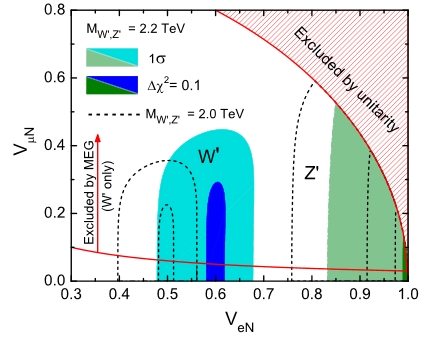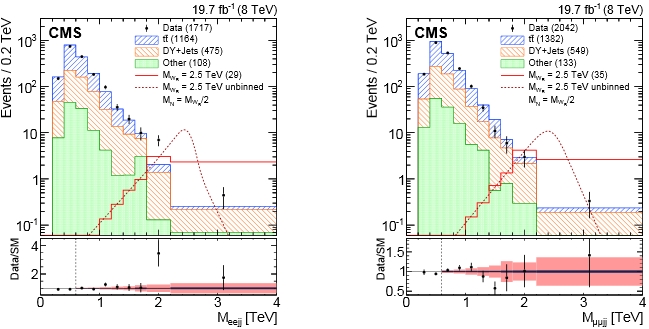Alas, no. I only discovered that the signal which the theorists refer to is a mere 2.8σ statistical fluke in a wide mass histogram, practically a single high bin in the four-body mass distribution of events with two electrons and two hadronic jets. A local significance of 2.8 standard deviations means very little, as globally the probability to see one such effect is well above the few percent level. In the CMS article I found no mention of the fluctuation in the abstract, and I had to dig into the text to find it. Relieved by seeing that I had not lost track of my experiment's scientific output, I then gave a closer look at the phenomenological paper.
The theorists considered a model called "see-saw" which is an attempt to explain the non-zero mass of neutrinos with the existence of heavy partners of the W and Z bosons, W' and Z'. The model naturally also fits in heavy neutrinos as partners of the right-handed fermion fields. The CMS search also considered that model, and concluded that the local fluctuation, besides being not statistically significant once one considered the number of places where it could have arisen, did not have the kinematical characteristics that would be expected for two electrons and two jets produced in the decay chain pp-> W' -> l N -> l l W'* -> l l j j, where "l" indicates a lepton (of any kind), "j" indicates a hadronic jet (here due to the W' decay into a quark pair), and N, W' are the new hypothetical particles. But the theorists extended the net and tried to interpret the data in a broader context, also considering the possibility of pair-production of heavy neutrinos from a Z', as in pp -> Z' -> NN -> lW' lW' -> ll jjjj, which has two extra jets in the event.
The CMS data being public, anybody can read off event counts and predicted backgrounds in the mass distribution. So that is what is done here: with that information, a fit can be performed to extract the most likely model parameters, assuming specific masses for the W' and Z' bosons. Unfortunately, such a method, which does not account for the kinematics of the processes, has very little power, and the conclusions that can be drawn are not compelling. But for a study that starts off from an O(1%) statistical fluctuation, I guess this is reasonable... On the other hand, it is the responsibility of the experimental collaborations to release more information about their data, if they want them to be used to the fullest. I thus sympathize with the complaints hidden between the lines of their paper.
 As an example of the output of the fit, on the right you can see the favoured region of the model parameters V_μN and V_eN, the couplings of the heavy neutrino to muons and electrons. The W' hypothesis (with a mass of 2.2 TeV) holds well for small couplings of the heavy neutrino to the muon, as there is very little excess in the μμjj CMS data; similarly, the Z' couplings are pushed to the bottom right corner. It is to be noted that the "favoured region" for a W' is almost entirely excluded by searches for muon decay to electron and photon by the MEG experiment (all the part of the plane above the almost-horizontal red line at the bottom).
As an example of the output of the fit, on the right you can see the favoured region of the model parameters V_μN and V_eN, the couplings of the heavy neutrino to muons and electrons. The W' hypothesis (with a mass of 2.2 TeV) holds well for small couplings of the heavy neutrino to the muon, as there is very little excess in the μμjj CMS data; similarly, the Z' couplings are pushed to the bottom right corner. It is to be noted that the "favoured region" for a W' is almost entirely excluded by searches for muon decay to electron and photon by the MEG experiment (all the part of the plane above the almost-horizontal red line at the bottom).Let me now show you the data which drove the authors of the study to investigate the implications for see-saw models. They are shown in the distributions below. As you can see, CMS observed a single high bin in the mass distribution of eejj events, while very little in the corresponding μμjj sample. The experimentalists in fact did not even bother mentioning the fluctuation in the abstract of their paper, but I realize that with minimal SUSY being pushed in the hostile region of high fine-tuning and the lack of exciting signals in the hundreds of searches produced by ATLAS and CMS in Run 1, it is hard to make a living for a phenomenologist these days, so one must cling one's hopes to the occasional faint fluctuation that does appear here and there by force of statistics.

Above: 4-body mass in the eejj final state from 20/fb of 8-TeV pp collisions (black points with error bars) compared to the sum of background predictions (mostly contributed to by top pair production and Drell-Yan). A 2.5 TeV W' signal is overlaid for comparison in red dashes and empty histogram. On the right, the μμjj data is similarly compared to background and W' signal.





Comments